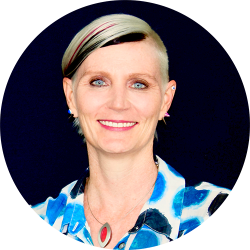
Communication is everyone’s business! Tackling the isolation felt by those impacted by communication difficulties after stroke and other brain injuries has turned into the work of a lifetime for Associate Professor Emma Power.

Associate Professor
Emma Power
And although the reward is in the work and the results, it’s always gratifying to receive recognition and funding.
So, the year ended well with The Centre for Research Excellence in Aphasia Rehabilitation and Recovery announced in The Australian’s Research Magazine 2023 as one of the top five Australian research institutes and centres tackling one of 10 identified major challenges for society in the category of ‘Disability and Rehabilitation’.
The Centre is a national collaboration between the UTS Graduate School of Health and La Trobe University and other Australian universities. It aims to transform the health and wellbeing of people with aphasia and their families through research that leads to enhanced, cost-effective and sustainable interdisciplinary aphasia rehabilitation and community services.
“Aphasia is a communication disability caused by damage to the language networks of the brain, often occurring in stroke, traumatic brain injuries, dementias and tumours,” Emma said.
“It affects peoples to express themselves verbally, understand others and to read and write. but aphasia is not a disorder of intelligence. That is where the isolation and challenge lie, because people judge intelligence by an individual’s ability to communicate. People with aphasia are more likely to have difficulty with low mood and depression as well as fewer friendships. One study even showed that 12 months after a stroke, 30 per cent of participants with aphasia had no friends.
“This has a profound effect on people’s lives because it effects everything – relationships, productivity, self-worth and identity.”
However, there is much we can all do to improve language abilities of those with aphasia and to assist them to reconnect to a new life successfully living with aphasia.
It was this message of positivity and hope that Emma gave in her ABC Sydney Radio Interview this year, borrowing a metaphor from physical disability, Emma calls her work “a communication ramp”. She works with those affected by acquired brain injury, their families and their healthcare professionals to promote techniques to facilitate good communication, called Communication Partner Training.
Emma and her team have developed online communication partner training programs launched this year as part of the Social Brain Toolkit, that provide key strategies to help loved ones, healthcare staff and community members understand how best to communicate with people with brain injuries.
The program promotes tools to smooth the path to communication.
Communication is everyone’s business! The first thing we would do is to acknowledge the competence of a person with aphasia by talking normally, and not raising our voice. People with brain injury hate that.
Emma Power
Other techniques include:
- using pictures as a communication aid,
- writing down key words,
- using a phone to write a list of things,
- giving people options so all they have to do is choose,
- scaffolding communication, which allows people to add detail to an existing structure,
- teaching people to slowdown or simplify their communication.
Emma’s work on communication inclusion received a huge boost this year as a member of an Australian team that was awarded a $10 million grant to create a digitally enabled young stroke service to meet the long-term care needs of young people who experience stroke.
Emma will lead a team to ensure that the digitally enabled service is communicatively accessible for young stroke survivors with aphasia. Emma says “Communication is now online so much, especially for young people, so you can imagine how challenging it can be for young stroke survivors with aphasia to connect with their friends, to perform in their jobs and manage their healthcare if their language is affected. We are codesigning an online platform that will maximise people with aphasia’s ability to manage their own healthcare and recovery from young stroke. So young stroke survivors can be all they want to be.
“Let’s not forget that in the sliding doors of life, all of us can take our communication for granted, but we could all be in a situation where suddenly we cannot express our thoughts and feelings and understand others due to a brain injury or disease Emma said.
“This is work that profoundly affects the lives of people with aphasia, as well as the people who love and care for them”

Find out more
For more information about our research impact in the Faculty of Health or for collaboration opportunities, contact:
Professor Angela Dawson
Associate Dean of Research, Faculty of Health
E: Angela.Dawson@uts.edu.au
T: +61 (02) 9514 4892
PO Box 123 Broadway NSW 2007 Australia

